The pristine alternative to Bali few Australians know about
On the south-west coast of Sumba, in a village called Waro Wora, I am learning to communicate with ancestral spirits using a chicken’s heart. With a mouth stained crimson from the betel nut our small group has been sampling, our Sumbanese guide places her palms on the bamboo floor of the traditional house we’re in and explains.
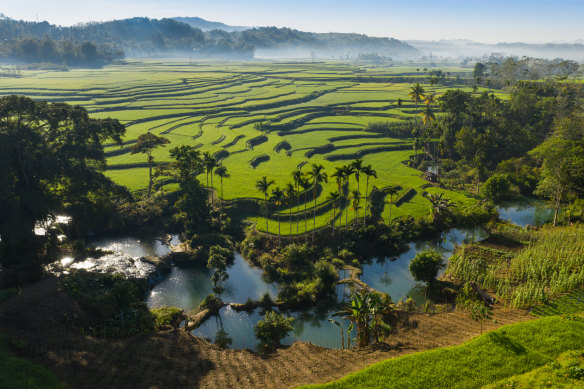
Sumba is home to largely a subsistence culture.
“When a man wants to speak with the ancestors, he asks the local rato, or shaman, a question in traditional dialect, then the rato kills a chicken and opens its heart to see what the spirits reply.”
Looking around this village, where 25-metre pyramidal, grass-roofed houses huddle around megalithic stone graves, I think for what must be the 15th time today just how astonishing it is that hardly anyone seems to know about this island.
The thought first crossed my mind when my husband and I drove 90 minutes from the airport, past thick jungle, rolling rice paddies, fields of corn and cassava and the occasional dusty village, without seeing a single hotel or restaurant. It popped up again last night, during a sunset picnic overlooking an unspoilt stretch of coastline that in many other parts of the world would have been encrusted with hotels and crawling with tourists.
But tell the average Australian you’re visiting Sumba, an island twice the size of Bali yet with roughly a sixth of the population, and they’ll likely think you’re starting Zumba classes. Maybe it’s the extra 90-minute flight from Denpasar, or the lack of shops or restaurants, but for now Sumba remains the much quieter, far less developed alternative to Bali, and one of Indonesia’s last wild frontiers.
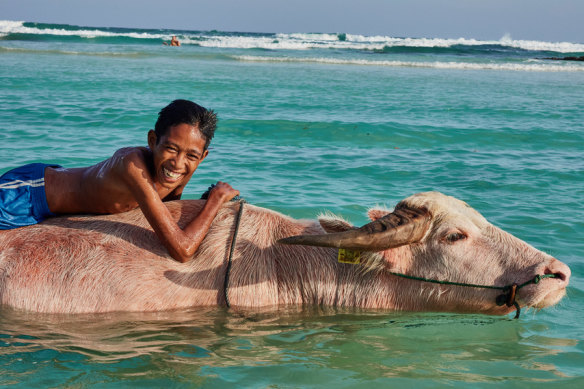
In the water at Ngalung Kalla.
Happily, most tourism development that is happening on Sumba is thoughtful, focused on environmental sustainability and the wellbeing of local communities. And while visiting Sumba historically meant either paying upwards of $2000 a night to stay at Nihi Sumba – a resort that has been almost synonymous with the island since opening in 2005 and that offers private access to a coveted surf break – or choosing a basic homestay, there are now an increasing number of options that fall in the middle.
Alamayah, our south Sumba landing pad that opened in mid-2020, is one of them. Owned by an Australian couple in their 30s who trained more than 120 Sumbanese to build the six-suite retreat, Alamayah is entirely staffed by locals and set directly across the road from the beach. It’s tempting to spend all our time lazing in the breezy lounge areas surrounding the pool, or in our elegant room, decorated with the fine ikat woven fabrics and hand-carved stone statues the island is renowned for. This is not, however, an island to waste on a fly and flop, and we’re happily ushered outside into nature.
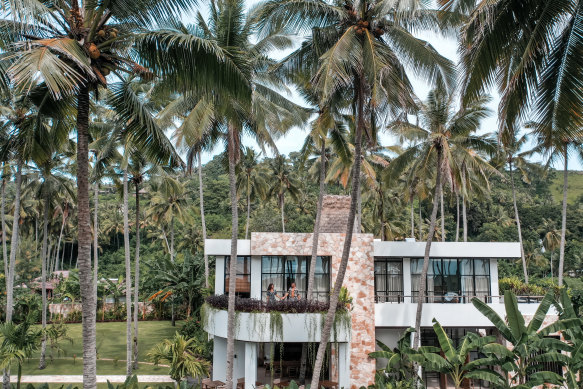
A villa at Alamayah.
Sumba is home to largely a subsistence culture, and as we snake along the jungle-lined dirt roads on electric bikes we see farmers tilling rice fields, villagers gathering taro root, and families boiling seawater on open fires to make salt.
The villages scattered across the island are a step back in time. Here, men still wear swords strapped to their sides and the indigenous Marapu belief system, which dates back to the Bronze Age, is still very much alive. Marapu is rooted in animism and the worship of ancestors, who are invoked and consulted by the local rato during marriages, births, deaths, house constructions and other important rituals.
After learning about the reading of chicken hearts in Waro Wora, we watch women weaving ikat on shaded balconies and meet a woman who tells us she is 121 years old. Her keys to longevity? Family and laughter. Sumba is Indonesia’s most economically impoverished island, but it’s impossible to deny the wealth of community and contentment when observing village life.
Following the single narrow road up the island’s western coast, where the jungle combines with dry swathes of limestone hills, we arrive at Cap Karoso. Fronting onto 10-kilometre Karoso beach, this resort is Sumba’s newest drawcard.
Created by French couple Evguenia and Fabrice Ivara, it is a sign of things to come. The 47 suites are decorated with local artefacts and ceramics, exterior walls are made from stacked local limestone, native grasses cover the rooftops and the whole place is underpinned by the philosophy of putting the area’s culture and communities first.
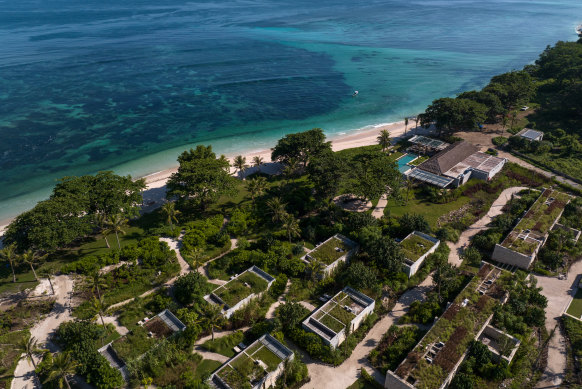
The ocean-front Cap Karoso beach resort and farm all in one.
One morning at Karoso, we ride e-bikes five minutes up the road to their three-hectare organic farm, where we pass rows of lettuce, sugarcane, eggplant and taro, and learn about the program they are implementing to train locals in organic farming and seed saving. Continuing on to Weekuri Lagoon, we leap into the turquoise-coloured water like teenagers and sip strong coffee on the shore while chatting with our Sumbanese guide.
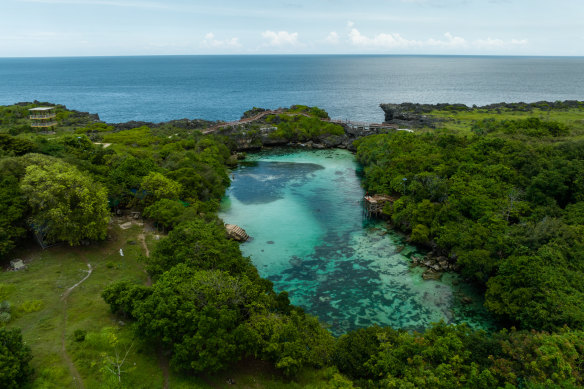
The lagoon at Cap Karoso.
Later, back at Cap Karoso, we follow a sandy lemongrass-lined path to the shore. As we watch the tide drop with the sun, a local boy trains a wild horse on the shore, while locals fish the shallow waters. In other parts of Indonesia, this moment would be punctuated by the calls of touts.
Here, we are disturbed by no-one and as it grows dark, we watch wooden dugout canoes being rowed home under a new moon.
Our final stay in Sumba, while less polished, feels more authentic and in-step. Arriving at the clifftop eco-retreat Ngalung Kalla, we’re greeted in their pavilion-style restaurant by 180-degree ocean views and the owner, Christian Sea, a bright-eyed Hawaiian surfer who was the waterman at Nihi Sumba for 10 years before opening his own retreat.
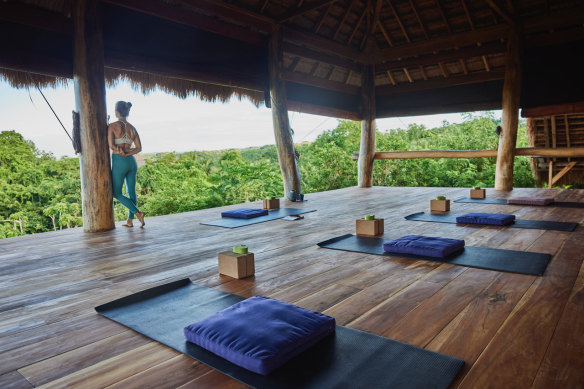
Yoga space at Ngalung Kalla.
Sea lives on the property with his wife and three daughters and has spent the past decade building it up from a single tent to the impressive operation it is today. The six bungalows are in the local grass-roof style, and since they don’t have walls they take nothing away from the raw beauty of the landscape.
Ngalung Kalla is founded on the principles of permaculture, a system designed to mimic natural ecosystems, and the property functions as an almost completely closed-loop system. The flourishing food forest and organic vegetable gardens make up most of our delicious meals, alongside fish caught by staff that day and eggs laid by their chickens.
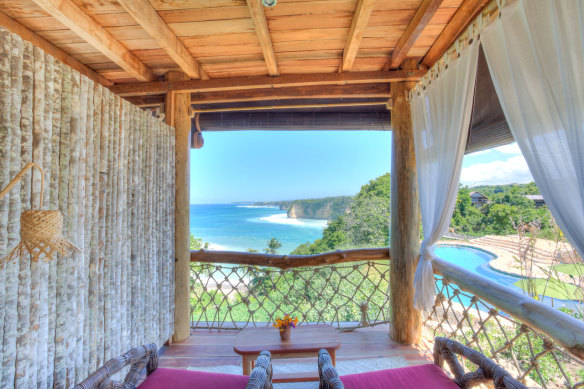
Room and a view at Ngalung Kalla.
Timber is harvested and milled on-site to build furniture, native grasses are grown to repair bungalow roofs, and the property runs entirely on solar power. Sea has also bought surrounding tracts of forest to protect against development, and has created a marine protection area in the 400-metre-long bay fronting the property. “We just want to do good work, preserve this place and be good neighbours,” he says.
Days at Ngalung Kalla trace the rhythm of the tides: morning paddleboard sessions and yoga classes, followed by afternoon boat trips to snorkel, fish and (attempt to) surf, or hikes to the local village.
We quickly get used to living in harmony with nature, to not having windows and doors, to the complete lack of mod-cons, to composting toilets, even. By the time we leave, we don’t need a rato or a chicken heart to tell us we’ll be returning to Sumba – and soon – before the rest of the world discovers it.
THE DETAILS
Stay
Rooms at Alamayah from $445 a night (alamayah.com); Cap Karoso suites from $450 a night (capkaroso.com); Ngalung Kalla bungalows from $485 a person a night, inclusive of all food, non-alcoholic drinks and most activities (ngalungkalla.com). Best time to visit is the dry season (May to October) or for the Pasola festival (February or March), where men dressed in traditional costumes fight on horseback with sticks.
Fly
NAM Air, Wings Air and Citilink operate daily flights from Bali to Sumba, ranging from 50 to 90 minutes. NAM is a jet and therefore the fastest option. See flynamair.com
More
See indonesia.travel
The writer travelled with assistance from Alamayah, Cap Karoso and Ngalung Kalla.
Sign up for the Traveller Deals newsletter
Get exclusive travel deals delivered straight to your inbox. Sign up now.